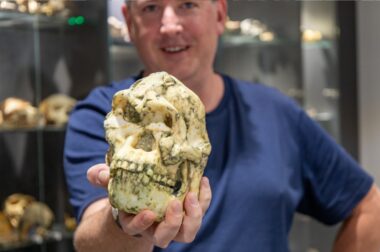Landmark study finds that the shape of the brain influences the way it works
For over a century, researchers have thought that the patterns of brain activity that define our experiences, hopes and dreams are determined by how different brain regions communicate with each other through a complex web of trillions of cellular connections.
Now, a Monash University Turner Institute for Brain and Mental Health-led study has examined more than 10,000 different maps of human brain activity and found that the overall shape of a person’s brain exerts a far greater influence on how we think, feel and behave than its intricate neuronal connectivity.
The study, published today in the prestigious journal, Nature draws together approaches from physics, neuroscience and psychology to overturn the century-old paradigm emphasising the importance of complex brain connectivity, instead identifying a previously unappreciated relationship between brain shape and activity.
Lead author and Research Fellow Dr James Pang, from the Turner Institute and Monash University’s School of Psychological Sciences, said the findings were significant because they greatly simplified the way that we can study how the brain functions, develops and ages.
“The work opens opportunities to understand the effects of diseases like dementia and stroke by considering models of brain shape, which are far easier to deal with than models of the brain’s full array of connections,” Dr Pang said.
“We have long thought that specific thoughts or sensations elicit activity in specific parts of the brain, but this study reveals that structured patterns of activity are excited across nearly the entire brain, just like the way in which a musical note arises from vibrations occurring along the entire length of a violin string, and not just an isolated segment,” he said.
The research team used magnetic resonance imaging (MRI) to study eigenmodes, which are the natural patterns of vibration or excitation in a system, where different parts of the system are all excited at the same frequency. Eigenmodes are normally used to study physical systems in areas such as physics and engineering and have only recently been adapted to study the brain.
This work focused on developing the best way to efficiently construct the eigenmodes of the brain.
“Just as the resonant frequencies of a violin string are determined by its length, density and tension, the eigenmodes of the brain are determined by its structural––physical, geometric and anatomical––properties, but which specific properties are most important has remained a mystery,” said co-lead author, Dr Kevin Aquino, of BrainKey and The University of Sydney.
The team, led by the Turner Institute and School of Psychological Sciences ARC Laureate Fellow, Professor Alex Fornito, compared how well eigenmodes obtained from models of the shape of the brain could account for different patterns of activity when compared to eigenmodes obtained from models of brain connectivity.
“We found that eigenmodes defined by brain geometry––its contours and curvature––represented the strongest anatomical constraint on brain function, much like the shape of a drum influences the sounds that it can make,” said Professor Fornito.
“Using mathematical models, we confirmed theoretical predictions that the close link between geometry and function is driven by wave-like activity propagating throughout the brain, just as the shape of a pond influences the wave ripples that are formed by a falling pebble,” he said.
“These findings raise the possibility of predicting the function of the brain directly from its shape, opening new avenues for exploring how the brain contributes to individual differences in behaviour and risk for psychiatric and neurological diseases.”
The research team found that, across over 10,000 MRI activity maps, obtained as people performed different tasks developed by neuroscientists to probe the human brain, activity was dominated by eigenmodes with spatial patterns that have very long wavelengths, extending over distances exceeding 40 mm.
“This result counters conventional wisdom, in which activity during different tasks is often assumed to occur in focal, isolated areas of elevated activity, and tells us that traditional approaches to brain mapping may only show the tip of the iceberg when it comes to understanding how the brain works,” Dr Pang said.
Key Facts:
Decades of scientific thought about how the brain works has been challenged
Brain shape not connections between different portions of the brain control how we move, think and remember
Major study of over 10,000 people's MRIs - study published in Nature
Contact details:
Tania Ewing
0408378422


